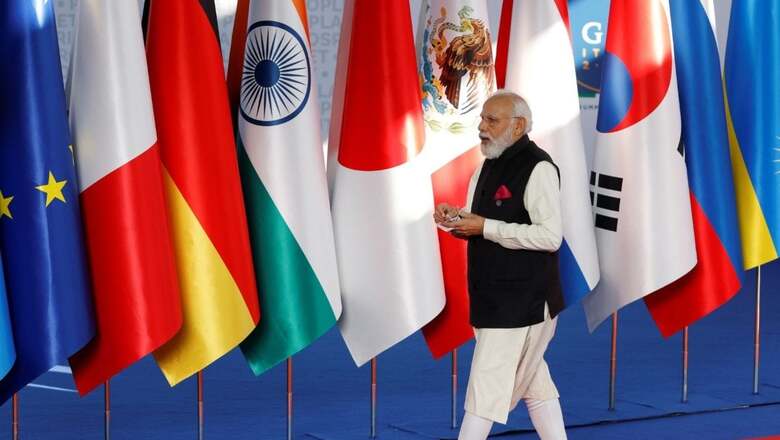
views
The last few weeks have been very interesting from the perspective of diplomatic outreaches. Many high-level meetings have taken place between different power centres that are looking to mend their relations with each other. On one hand, the United States has dispatched its veteran diplomat Henry Kissinger to China to defrost ties between the two countries. On the other hand, China has also sent conciliatory signals towards India after the conclusion of a meeting between India’s National Security Advisor Ajit Doval and China’s top diplomat Wang Yi.
Despite these attempts at repairing ties, one thing that is not going to change is that great power consensus is going to be an elusive reality of our times. Nothing speaks more strongly of this than US military aid of $345 million approved for Taiwan last week which brings its total commitment to the self-ruled nation to around $20 billion now. A similar story is unravelling in the case of the India-China relationship as well. The statement released by China after the Doval-Wang meet noted that Prime Minister Narendra Modi and President Xi Jinping had reached an ‘important consensus’ over stabilising ties in Bali but New Delhi’s version of the same meet lacked any reference to it.
What’s more, is that the Indian Ministry of External Affairs did clear the air about such an articulation at the G20 summit in Bali but it also quickly clarified that any resolution on that front is firmly dependent on the situation at the LAC. In a world where there may be desires to reconcile at the level of top leaderships, the truth is that the structure isn’t very kind to these conciliatory notes. China’s material rise is a reality and so is the waning of the West. In such a scenario, India’s consistent status as the fastest-growing major economy accompanied by a proactive foreign policy has created an excellent window of opportunity for the country’s rise in a transitory world.
Seven months of the current calendar year have passed and Prime Minister Modi has also paid visits to exactly seven countries including the United States and Papua New Guinea. If his US visit was a testament to the growing affirmation of India’s great power status then his visit to PNG signalled that despite a rise in rank and power status, India continues to feel empathetic for the cause of the global south. This sentiment was also on display when India organised a ‘Voice of Global South Summit’ in January 2023. With this India became the first G20 country to hear out the needs of the developing world to make it a part of the agenda of the grouping when India will organise its maiden summit in September this year.
Whether it is G20 or Shanghai Cooperation Organisation or even the BRICS summit, India’s voice is increasingly leaving an indelible mark on the proceedings. But this hasn’t silenced India’s critics. The detractors are saying that the G20 presidency is rotational in nature to avoid giving any credit to India’s excellent dance of democracy in the last few years. But the truth is that India’s past hesitancy of aligning with multiple power centres has been shed by the current administration for which it must get the due credit.
The Modi government from the very beginning had a clear vision of India’s foreign policy outlook. The BJP manifesto in 2014 outlined how it wanted to position India globally by speaking about the need of drawing upon India’s civilisational history to build its global stature. The massive mandate that Modi won by wooing the young population further aided him in adopting a foreign policy that entailed multiple paradigm shifts. This was evident in the way he shrugged off the non-alignment hangover of the previous government in driving a close relationship with the United States.
The defence relationship between India and US which was held hostage to the vagaries of coalition politics during Manmohan Singh’s tenure has bloomed into a meaningful partnership under Prime Minister Modi. India has also shed its hesitancy in recognising the global power-play as it is unfolding in the key theatres of Eurasia as well as the Indo-Pacific. Today India has built a strong relationship with each of its partners in the region including Japan and Australia and has emerged as a key stakeholder in the security architecture of the Indo-Pacific. However, India’s alignment with the West led by the United States hasn’t come at the cost of its traditional relationships.
Its relationship with Russia has also become deeper and broader in the last decade. India is seeking to diversify its defence procurement sources which means Russia’s importance in India’s overall defence preparedness may be decreasing but both countries are compensating for this by looking to forge deeper ties in the domain of connectivity such as through the International North-South Trade Corridor and through India’s investment in the resource-rich Russian far east.
India’s proactive diplomacy has definitely paid handsome dividends for the country in the last decade. Prime Minister Modi has emerged as the most travelled Indian prime minister in history with 128 visits till date. But what’s also notable is India’s economic story which has given the much-needed push of material capability to its foreign policy. India is on the mission to become a consequential world power by 2047 when it will complete the 100th year of its independence from the British. In order to achieve that goal, it is looking to build its national power as evident in the launch of multiple initiatives such as Make in India by Prime Minister Modi.
Today its foreign policy has become a tool for India to fulfil this objective. Each visit by Prime Minister Modi involves him pitching these flagship schemes to the audience of global big businessmen. During the US tour as well, he made sure to meet potential investors at the CEOs’ meeting. There is a link between India’s economic rise and its geopolitical ambitions, leading major powers to take notice. It is not only India’s friendship but its market which is also proving to be alluring. With a demographic dividend in place and the burgeoning middle class, global majors such as Apple are vying to secure a share in Indian opportunity. The twin drivers of geopolitics and geo-economics are leading India towards an era of global relevance. The best way to leverage this is to focus on India’s economic growth and invest in the country’s diplomatic partnerships.
The author is a PhD from the Department of International Relations, South Asian University. She writes on India’s foreign policy. Views expressed in the above piece are personal and solely that of the author. They do not necessarily reflect News18’s views.




















Comments
0 comment